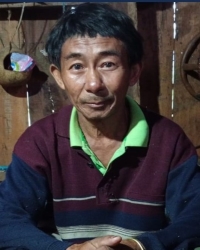Akha Ker in Laos

Photo Source:
Anonymous
|
Send Joshua Project a map of this people group.
|
| People Name: | Akha Ker |
| Country: | Laos |
| 10/40 Window: | Yes |
| Population: | 3,300 |
| World Population: | 3,300 |
| Primary Language: | Akha |
| Primary Religion: | Ethnic Religions |
| Christian Adherents: | 0.00 % |
| Evangelicals: | 0.00 % |
| Scripture: | Complete Bible |
| Ministry Resources: | Yes |
| Jesus Film: | Yes |
| Audio Recordings: | Yes |
| People Cluster: | Hani |
| Affinity Bloc: | Tibetan-Himalayan Peoples |
| Progress Level: |
|
Introduction / History
The Ker people exist with hardly any footprint for the world to find them. They have eluded researchers and even, perhaps, missionaries. One of the lesser-documented subgroups of the Akha ethnic minorities, the Ker live in 11 villages in Phongsaly province. They seem to be different from the Kher people, who live in Oudomxay and Luang Prabang provinces. However, it is possible they migrated at the same time from China, likely in the 16th or 17th centuries, fleeing unrest, and also later in the 20th century.The Akha tribes make up the 9th largest ethnic group in Laos, and the Ker people are a small subtribe of the Akha. The language of the Akha is part of the Tibeto-Burman family, and they maintain an oral tradition without a written script. All Akha subgroups speak dialects of the Akha language. Dialects vary, but most understand the jeu g'oe dialect used in southern China, Thailand, and Myanmar. While some of the tribes do interact some, they remain distinct. Sometimes significant language differences exist with some groups: they speak completely unintelligible languages to other Akha. The gospel does not naturally flow from one group to the next.
What Are Their Lives Like?
Like other tribal communities, the Ker are known for their distinct culture and traditional attire. They live largely outside the country's economic system in remote areas, farming rice and corn, and raising chickens, pigs, water buffalo and goats. Oftentimes remote people groups found in Phongsaly province live in small, high-elevation villages (300–350 people) in huts built from wood, bamboo, and thatch, featuring “spirit gates” with carvings to ward off evil spirits. Houses are gender-divided, reflecting spiritual beliefs. Akha society is patriarchal, with men as headmen overseeing rituals and disputes. Women handle domestic tasks and crafting, with fewer rights. Akha women across subgroups wear elaborate headdresses (u-coe), adorned with silver coins, beads, and threads, signifying age, marital status, and subgroup identity. These can weigh several kilograms and are rarely removed. Men often wear modern clothing, though some retain traditional blue trousers and jackets. These remote subgroups typically practice slash-and-burn agriculture, growing rice, corn, and sometimes coffee.
What Are Their Beliefs?
The Ker, like most Akha subgroups, practice animism, worshipping ancestors and nature spirits. Rituals like “yukham” (postpartum fire rituals) and “kalum” (temporary prohibitions) are common. They fear the spirit world and believe they can be helped or harmed by these spirits. Often, they get the help of shamans and other religious specialists for rituals to appease spirits. People with this worldview often open their hearts more quickly to the gospel since Christ offers protection from the spirits.
What Are Their Needs?
The isolation given by the remote terrain means the Ker face limited access to education, healthcare and infrastructure. While it preserves cultural traditions, it also contributes to marginalization. Like most people in rural Laos, the Ker are among the poorest hill tribes. Opium addiction affects one in ten Akha, and HIV/AIDS rates are high, with women often bearing economic burdens.
Prayer Points
Pray that the Lord will give them dreams of his loving and omnipotent Holy Spirit, who will protect them and guide them.Pray for the Holy Spirit to do miracles among the Ker people, showing them God's power and care.Pray for other tribal representative whom God has reached, who will courageously go to them with the message from their Father God. Pray for disciples who will make more disciples.Pray for their physical and spiritual needs to be met by our generous God.